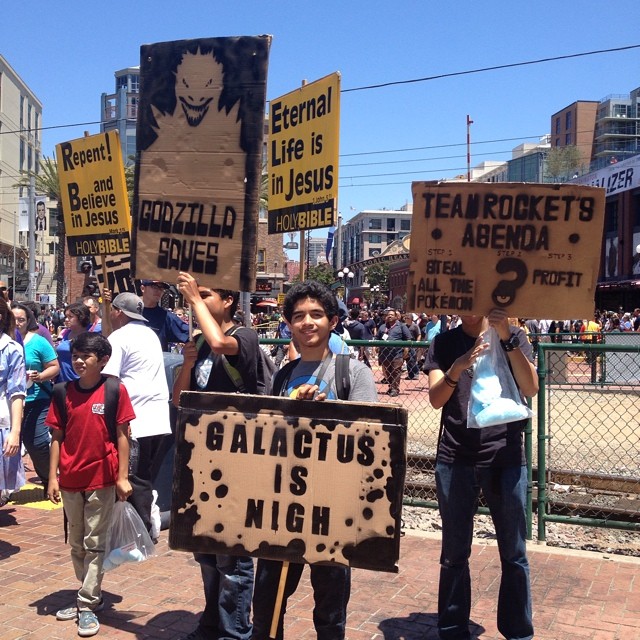Veteran NY Times entertainment business writers Michael Cieply and Brooks Barnes have perhaps put the final curse on a year in which SDCC got a little bit smaller, by reviving claims that con-goers are low rent consumers unworthy of high end sponsorships:
In truth, companies that might flock to a Tribeca Film Festival, which for years was backed by American Express and now has AT&T as its lead sponsor, would do well to stick with the soft sell here, because nobody is buying much.
In a recent report from the San Diego Convention Center, where Comic-Con is held, the fantasy fans ranked first in terms of the convention center’s attendance, far outstripping the combined total of its next four largest conventions, expected to be about 62,500 people.
But the Comic-Con fans were expected to spend only about $603 each during a convention that began Wednesday night and ran through Sunday. And that was only a little more than a third of the per-capita spending by those who showed up for the American Association for Cancer Research gathering in April, and similarly lower than per-person spending at the next three largest conventions in San Diego.
At Comic-Con, dining out is apt to mean eating a sandwich while squatting on a city street.
While it’s hard to forget the searing third world image of packs of con attendees roaming the streets and gnawing chicken bones in the doorway of the Hard Rock while eluding security (isn’t there a new Image comics about this?) the whole “no one spends money at Comic-Con” still seems to be a bit of a holdover from older arguments about why the show had so little impact on the city. I’ll be back later with a longer wrap up of all the huge changes this year at the show—and intimations of more—but
(Photo by Chandler Moses for ComicsBeat)








I actually got into an argument with one of the fan goers over this about 5 years ago. Even then many attending the Con were not spending a lot of money, especially the 4 day attendees. I myself was limited to about $1500 for all “5” days (including preview night) and had to be frugal on what I wanted to spend money on.
The argument was about limiting or just outright eliminating the 4 day passes altogether, where each attendee was limited to 1 single day pass each. Hypothetically, if each attendee had $1000 to spend, 100,000 (attendees) x $1000 = $100,000,000 per day, or 4 x $100,000,000 = $400,000,000.
His argument, or at least my understanding of it, was 4 day attendees spend more money at the Con than single day attendees. He may or may not be right in this regard, but if human nature is any consideration, single day attendees are more likely to spend all their money at the Con than 4 day attendees. Again, if 4 day attendees have $1000 to spend, how does $250 x 4 = $1000 x 100,000 = $100,000,000 over 4 days compare to the potential $400,000,000 that could be made?
Apparently he wasn’t good at basic math. And again, this is strictly hypothetical, but it makes sense, does it not?
The only “losers” here would be the hotels, even then I don’t think they would suffer that bad.
When folks spend upwards of 650 to fly out, 200+ a night for a hotel and whatever amount their tickets cost, how much money do you think they have left to throw around town, much less blow INSIDE the convention? Why do you think the lines for anything free are insane and the booths with the most giveaways are constantly packed? People are just trying to get their moneys worth. from another angle, ask the booths with sold out exclusives if the con goers spent money.
ONLY $650 a day?!
When did $603 become a small amount of money for most people? I do pretty well for myself and I think carefully before spending $100. Am I allowed to call New York reporters asshats here?
*AHEM*
From the San Diego Convention Center Corporation newsletter, dated January 2014:
http://www.visitsandiego.com/resources/sdccc2014forecast.pdf
Top Five Economic Generators
Name
Economic Impact
Direct Attendee Spending
Tax Revenues
hotel Room Nights
Attendance*
San Diego Comic-Con 2014
$177,800,000 $78,345,487 $2,634,511 55,772 130,000
American Association for Cancer Research
$63,300,000 $27,875,070 $937,350 35,600 17,000
Environmental Systems Research Institute (Esri)
$61,200,000 $26,958,110 $906,515 22,605 14,500
American Thoracic Society
$59,100,000 $26,020,480 $874,987 32,955 16,000
Experimental Biology
$57,700,000 $25,399,050 $854,090 24,510 15,000
55,772 room nights. (8% of the total nights for 2014, of 70 conventions.) Many at the legal maximum rate.
$78 345 487 / 130 000 = $602.66 (CCI:SD)
$27 875 070 / 17 000 = $1,639.71 (AACR)
Then there’s the glamour… Cities would kill for a marquee event like Comic-Con (or the College World Series, or Mardi Gras, or SXSW, or Sundance). Also consider that July is a dead month for conventions… most people are taking vacations.
Regarding expense accounts… there was scuttlebutt about local businesses killing the golden goose, by overcharging Hollywood for rental space. Hollywood then scaled back their spending this year.
Did restaurants experience vacancies? Or did the celebrities, studios, executives, attendees still eat out? Which month is the best for local restaurants?
So that’s why all the restaurants in the area were empty all weekend. Oh wait, they weren’t, were they?
Yeah, I’m not really feeling the pith of the NY Times entertainment writers on this one. Torsten (the master of facts & figures) debunks their notion with just one comment / post — even providing a link.
Haters gonna hate.
What a stupid article…. the cheapskates stayed at home because they could not afford the airfare, hotel, and the ComicCon tickets. WTF idiot. (Oh and lugging shit back on the plane is fun.)
Well, if we weren’t being charged $4 for a soda before getting the entree, which the kitchen screwed up, we might be inclined to spend a little more.
And yeah, I didn’t tip a full 15%. Why should I have to after that?
Buster’s Beach House in Seaport was pretty great and they’ll get my business- and 20% tip- in the future.
“At Comic-Con, dining out is apt to mean eating a sandwich while squatting on a city street. McCormick & Schmick’s, a high-end seafood restaurant across from the convention center, sold wraps from a cart, two for $10.”
McCormick and Schmick’s doesn’t sell water for less than $11. What’s their sourcing?
And this is what New York has become – a place where people look down on something that has failed to gentrify.
There is a lot of faulty logic in the article and comparing of apples to oranges.
First of all, film festivals are not consumer shows. Attendees at those events are mainly paying for travel, lodging, food, and the cost of attending the festival. In addition to those costs, Comic-Con attendees have to bring additional money for buying the goods at the shows. I noticed that the article doesn’t make any comparison of how much film festival attendees spend compared to Comic-Con attendees; it just talks about who the sponsors are.
And the spending comparison they DO make, is to a meeting of the American Association for Cancer Research. Who are the attendees here? Perhaps there are some “consumers” attending these shows, but it sounds like more of a professional conference that is likely sponsored/subsidized by healthcare, research, pharmaceutical corporate companies that often also sponsor the attendance of its employees at higher business rates for travel, hotel, food, etc. — just the cost of many medical conferences can easily run $1000 or more, which alone could account for the higher per capita spending.
So unless a more detailed assessment/comparison can be made with the data, I don’t think such a comparison is fair or valid.
Just a nit to pick but comics are gentrified as hell. That’s been the big issue of the last couple years and there are articles a’plenty about that here on the Beat and elsewhere. Hell, what’s more gentrified than paying 4.00 for a glossy 20 page floppy with 1/8 of a story in it?
Anyway, carry on…
I haven’t been to the San Diego Con, but I’ve never seen anyone collect sales tax at any of the other conventions I’ve been to.
I wonder what the city is losing there.
Hotel rooms are double or triple the normal price during Comicon. This started several years ago when it was noted that even hotels in Escondido (30 miles north of San Diego) were charging $300 a night instead of the normal $80 a night during Comicon. And parking lots downtown which normally charge $8.00 a day, charge $25 to $30 a day during Comicon, because they can.
jonboy: Believe me, the city gets its tax money, so no need to worry about that! Vendors are not allowed to exhibit without a valid California seller’s license–which Comic-Con (understandably) strictly enforces.
I used to collect sales tax, but as a small press publisher, asking and making change with coins was just too much of a hassle as opposed to dealing with bills. So I stopped collecting up front — I simply report my sales and pay the taxman out of pocket. (Sales tax are reported and paid on an annual fiscal year basis.)
Just because it’s not collected doesn’t mean it’s not getting paid — the exhibitor is likely just eating the cost and paying the sales tax out of pocket later. I guess the fact that as an exhibitor you don’t have to give up a portion of the sale to a middle-man/distributor helps make up the difference.
Comments are closed.